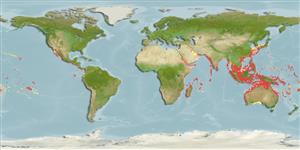Common names from other countries
Classification / Names / Names
Common names | Synonyms | Catalog of Fishes (gen., sp.) | ITIS | CoL | WoRMS
Environment: milieu / climate zone / depth range / distribution range
Ecology
Benthic; depth range 20 - 80 m (Ref. 93550). Tropical
Indo-Pacific: from East Africa to Melanesia and Easter Island.
Length at first maturity / Size / Weight / Age
Maturity: Lm ? range ? - ? cm Max length : 10.0 cm SHL male/unsexed; (Ref. 348); common length : 7.0 cm SHL male/unsexed; (Ref. 348)
Minimum depth from Ref. 106682. Collected for food in some areas. Shell used as raw material to make lime and for shellcraft (Ref. 348).
Life cycle and mating behavior
Maturity | Reproduction | Spawning | Eggs | Fecundity | Larvae
Members of the class Bivalvia are mostly gonochoric, some are protandric hermaphrodites. Life cycle: Embryos develop into free-swimming trocophore larvae, succeeded by the bivalve veliger, resembling a miniature clam.
Raines, B. and M. Huber. 2012. (Ref. 93550)
IUCN Red List Status (Ref. 130435: Version 2024-1)
CITES status (Ref. 108899)
Not Evaluated
Not Evaluated
Threat to humans
Harmless
Human uses
Fisheries: commercial
| FishSource |
Tools
More information
Age/SizeGrowthLength-weightLength-lengthMorphologyLarvaeAbundance
Internet sources
Estimates based on models
Preferred temperature
(Ref.
115969): 20.4 - 28.4, mean 27.3 (based on 515 cells).
Vulnerability
Low vulnerability (10 of 100).
Price category
Unknown.
